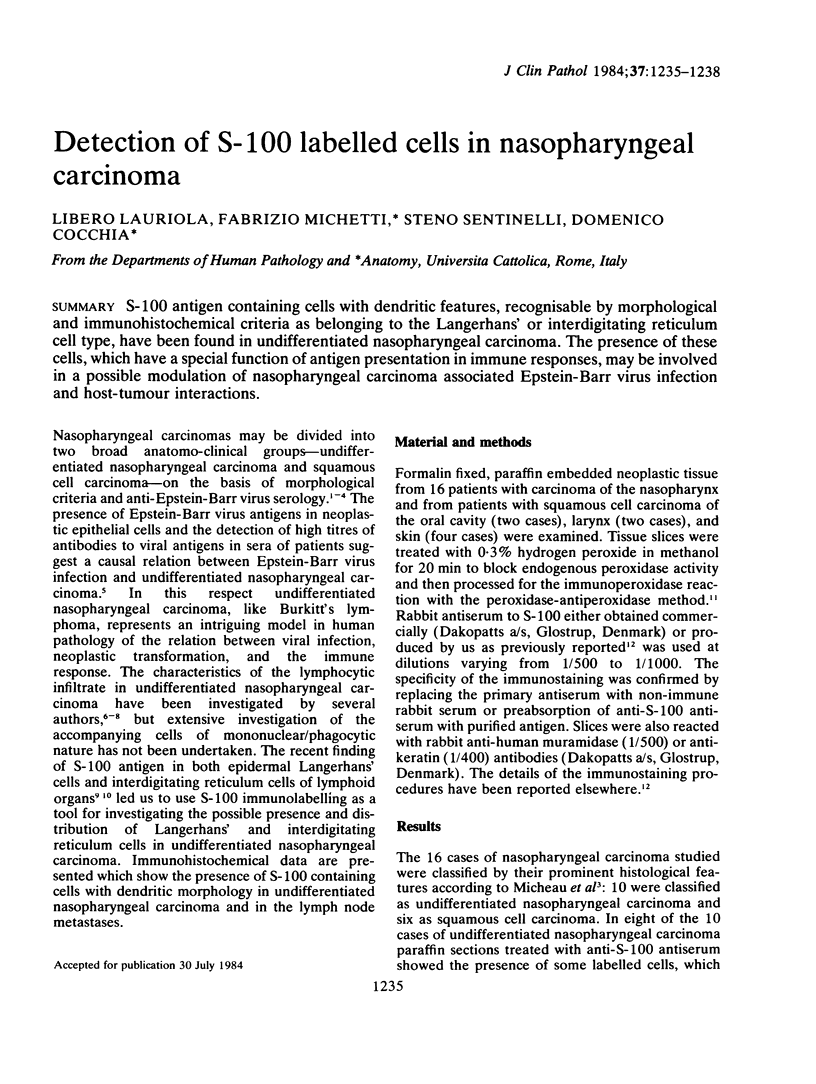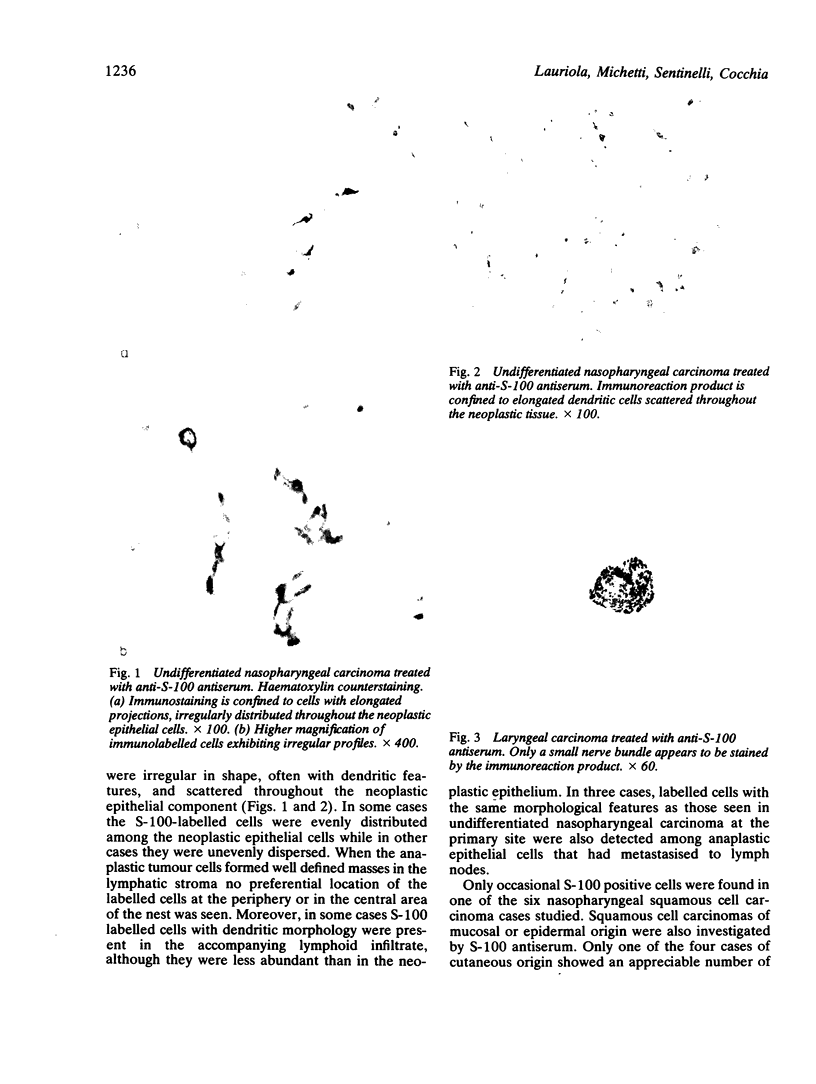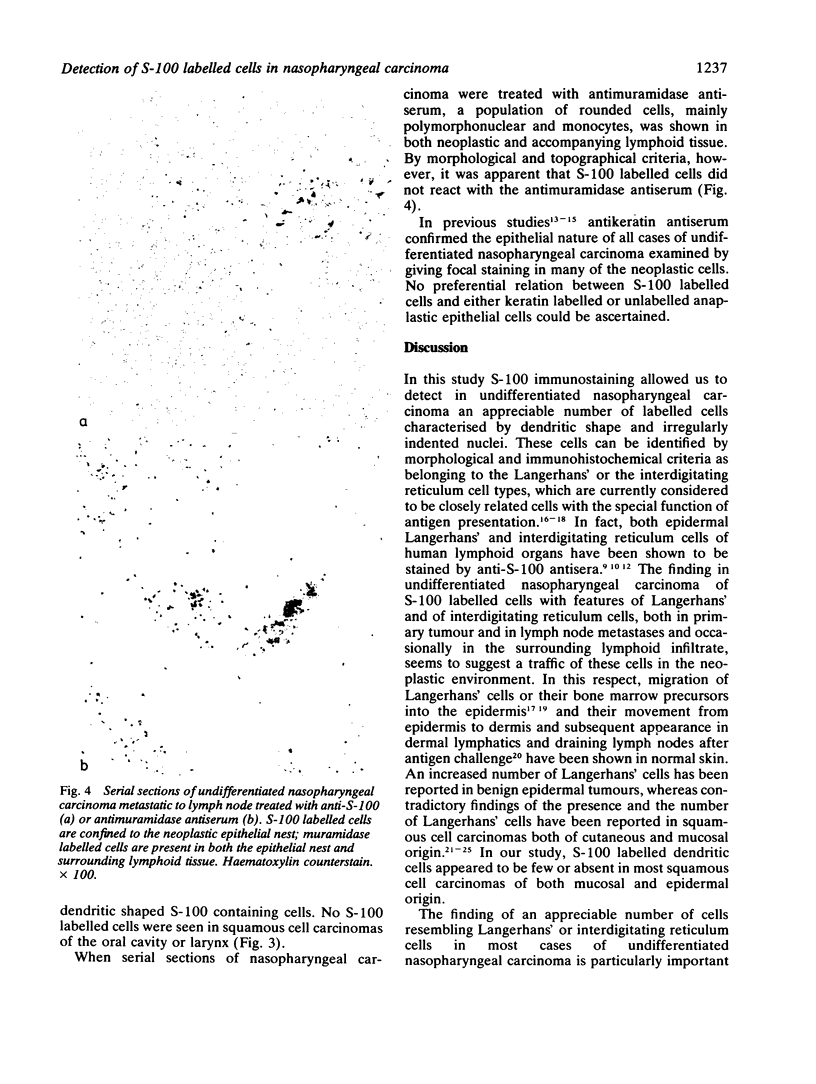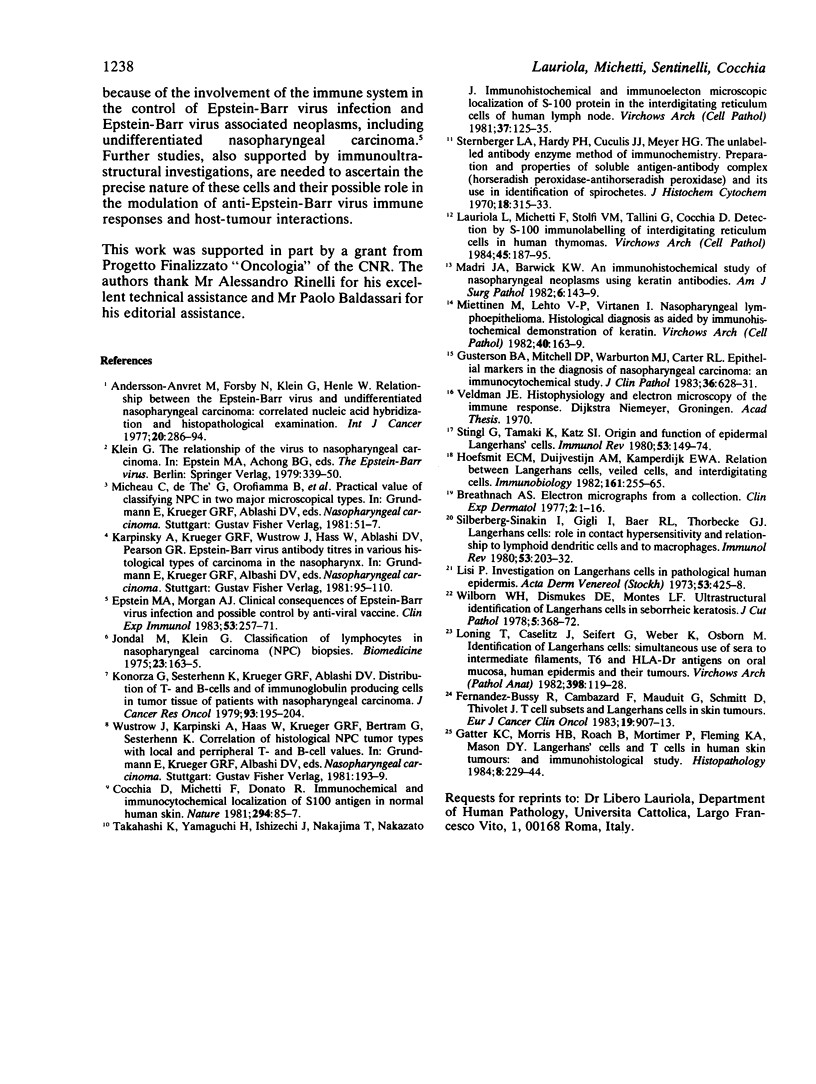Abstract
S-100 antigen containing cells with dendritic features, recognisable by morphological and immunohistochemical criteria as belonging to the Langerhans' or interdigitating reticulum cell type, have been found in undifferentiated nasopharyngeal carcinoma. The presence of these cells, which have a special function of antigen presentation in immune responses, may be involved in a possible modulation of nasopharyngeal carcinoma associated Epstein-Barr virus infection and host-tumour interactions.
Full text
PDF



Images in this article
Selected References
These references are in PubMed. This may not be the complete list of references from this article.
- Breathnach A. S. Prosser White Oration 1976. Electron micrographs from a collection. Clin Exp Dermatol. 1977 Mar;2(1):1–16. doi: 10.1111/j.1365-2230.1977.tb01531.x. [DOI] [PubMed] [Google Scholar]
- Cocchia D., Michetti F., Donato R. Immunochemical and immuno-cytochemical localization of S-100 antigen in normal human skin. Nature. 1981 Nov 5;294(5836):85–87. doi: 10.1038/294085a0. [DOI] [PubMed] [Google Scholar]
- Epstein M. A., Morgan A. J. Clinical consequences of Epstein-Barr virus infection and possible control by an anti-viral vaccine. Clin Exp Immunol. 1983 Aug;53(2):257–271. [PMC free article] [PubMed] [Google Scholar]
- Fernandez-Bussy R., Cambazard F., Mauduit G., Schmitt D., Thivolet J. T cell subsets and Langerhans cells in skin tumours. Eur J Cancer Clin Oncol. 1983 Jul;19(7):907–913. doi: 10.1016/0277-5379(83)90056-1. [DOI] [PubMed] [Google Scholar]
- Gatter K. C., Morris H. B., Roach B., Mortimer P., Fleming K. A., Mason D. Y. Langerhans' cells and T cells in human skin tumours: an immunohistological study. Histopathology. 1984 Mar;8(2):229–244. doi: 10.1111/j.1365-2559.1984.tb02338.x. [DOI] [PubMed] [Google Scholar]
- Gusterson B. A., Mitchell D. P., Warburton M. J., Carter R. L. Epithelial markers in the diagnosis of nasopharyngeal carcinoma: an immunocytochemical study. J Clin Pathol. 1983 Jun;36(6):628–631. doi: 10.1136/jcp.36.6.628. [DOI] [PMC free article] [PubMed] [Google Scholar]
- Hoefsmit E. C., Duijvestijn A. M., Kamperdijk E. W. Relation between langerhans cells, veiled cells, and interdigitating cells. Immunobiology. 1982 Apr;161(3-4):255–265. doi: 10.1016/S0171-2985(82)80081-8. [DOI] [PubMed] [Google Scholar]
- Jondal M., Klein G. Classification of lymphocytes in nasopharyngeal carcinoma (NPC) biopsies. Biomedicine. 1975 Jun 10;23(5):163–165. [PubMed] [Google Scholar]
- Konorza G., Sesterhenn K., Krueger G. R., Ablashi D. V. Distribution of T- and B-cells and of immunoglobulin-producing cells in tumor tissue of patients with nasopharyngeal carcinoma. J Cancer Res Clin Oncol. 1979 Feb 19;93(2):195–204. doi: 10.1007/BF00406578. [DOI] [PubMed] [Google Scholar]
- Lauriola L., Michetti F., Stolfi V. M., Tallini G., Cocchia D. Detection by S-100 immunolabelling of interdigitating reticulum cells in human thymomas. Virchows Arch B Cell Pathol Incl Mol Pathol. 1984;45(2):187–195. doi: 10.1007/BF02889864. [DOI] [PubMed] [Google Scholar]
- Lisi P. Investigation on Langerhans cells in pathological human epidermis. Acta Derm Venereol. 1973;53(6):425–428. [PubMed] [Google Scholar]
- Löning T., Caselitz J., Seifert G., Weber K., Osborn M. Identification of Langerhans cells: simultaneous use of sera to intermediate filaments, T6 and HLA-DR antigens on oral mucosa, human epidermis and their tumours. Virchows Arch A Pathol Anat Histopathol. 1982;398(2):119–128. doi: 10.1007/BF00618863. [DOI] [PubMed] [Google Scholar]
- Madri J. A., Barwick K. W. An immunohistochemical study of nasopharyngeal neoplasms using keratin antibodies: epithelial versus nonepithelial neoplasms. Am J Surg Pathol. 1982 Mar;6(2):143–149. doi: 10.1097/00000478-198203000-00006. [DOI] [PubMed] [Google Scholar]
- Miettinen M., Lehto V. P., Virtanen I. Nasopharyngeal lymphoepithelioma. Histological diagnosis as aided by immunohistochemical demonstration of keratin. Virchows Arch B Cell Pathol Incl Mol Pathol. 1982 Aug;40(2):163–169. [PubMed] [Google Scholar]
- Silberberg-Sinakin I., Gigli I., Baer R. L., Thorbecke G. J. Langerhans cells: role in contact hypersensitivity and relationship to lymphoid dendritic cells and to macrophages. Immunol Rev. 1980;53:203–232. doi: 10.1111/j.1600-065x.1980.tb01045.x. [DOI] [PubMed] [Google Scholar]
- Sternberger L. A., Hardy P. H., Jr, Cuculis J. J., Meyer H. G. The unlabeled antibody enzyme method of immunohistochemistry: preparation and properties of soluble antigen-antibody complex (horseradish peroxidase-antihorseradish peroxidase) and its use in identification of spirochetes. J Histochem Cytochem. 1970 May;18(5):315–333. doi: 10.1177/18.5.315. [DOI] [PubMed] [Google Scholar]
- Stingl G., Tamaki K., Katz S. I. Origin and function of epidermal Langerhans cells. Immunol Rev. 1980;53:149–174. doi: 10.1111/j.1600-065x.1980.tb01043.x. [DOI] [PubMed] [Google Scholar]
- Wilborn W. H., Dismukes D. E., Montes L. F. Ultrastructural identification of Langerhans cells in seborrheic keratoses. J Cutan Pathol. 1978 Dec;5(6):368–372. doi: 10.1111/j.1600-0560.1978.tb00967.x. [DOI] [PubMed] [Google Scholar]






